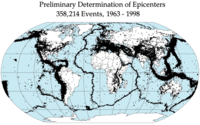
Photo from wikipedia
Abstract Deep ocean drilling revealed that shallow seismic slip in subduction zones is localized along weak pelagic clay, resulting in devastating tsunamis. However, the actual conditions of earthquake faulting in… Click to show full abstract
Abstract Deep ocean drilling revealed that shallow seismic slip in subduction zones is localized along weak pelagic clay, resulting in devastating tsunamis. However, the actual conditions of earthquake faulting in the deeper portions of subduction zones are largely unknown. The Jurassic chert–clastic complex in central Japan was formed under a cold subduction zone, within which the termination stage of superanoxia in the Middle Triassic was recorded in the pelagic sedimentary rocks. We conducted structural and Raman spectroscopic analyses of the fault rocks distributed along the thrust fault branched from the plate-boundary decollement. The results show that preferential melting of illite, thermal erosion, wall-rock fracturing, and increased carbonization are recorded along a few millimeter-thick pseudotachylyte derived from the black carbonaceous mudstone. A comparison of the clast volume fraction between the pseudotachylyte and black carbonaceous mudstone indicates that half amount of the clasts in the pseudotachylyte originate from the incorporation of fractured wall rocks composed of pelagic chert. Thermal modeling using the thermal diffusivities of wall rocks and the measurement of wall-rock fracture density suggest that fractured wall rocks represent thermal fracturing associated with the alpha–beta transition of quartz in the chert. Our pseudotachylyte study suggests that seismic slip at the deeper portions of the subduction zones is localized along the black carbonaceous mudstone flanked with chert. The intensely fractured wall rocks may be characteristic of pseudotachylyte, which accompanies quartz-rich wall rocks with high thermal diffusivities. The coseismic thermal fracturing of wall rocks potentially affects the dilatancy-induced fluid pressure drop in the slip zone and the reduction of wall-rock stiffness, resulting in the generation of frictional melt and acceleration of seismic slip.
Journal Title: Earth and Planetary Science Letters
Year Published: 2021
Link to full text (if available)
Share on Social Media: Sign Up to like & get
recommendations!